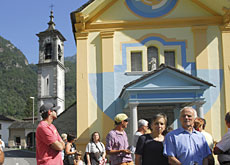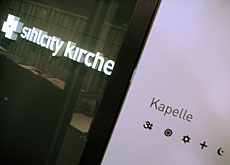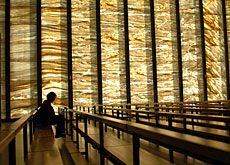Churches square up to numbers challenge

Switzerland's main Christian churches – the Roman Catholic and Reformed Protestant denominations – are haemorrhaging members.
Yet while they may not be sanguine about the state of their health, neither church believes the decline is terminal. Rather they are hopeful that they can stem the flow, and even attract new blood.
The 2000 census confirmed that pews across Switzerland are emptying. While 46.2 per cent professed allegiance to the Catholic Church in 1990, this figure had dropped to 41.8 per cent by 2000. Support for the Protestant Church meanwhile had fallen to 33 per cent from 38.5 per cent.
Sobering figures, which both churches seek to put in a social context.
“The church is a mirror of society,” says Markus Sahli of the Federation of Swiss Protestant Churches. “As society changes, so does the church.”
And Swiss society is changing. Migration over recent decades has altered the make-up of the population, with one in five in Switzerland a foreigner. Since 1990 the number of Muslims and Orthodox Christians in Switzerland has doubled – mainly owing to immigration from the former Yugoslavia.
To a certain extent this movement has also benefited the Catholic Church. According to the Federal Statistics Office, immigration from southern Europe has literally rejuvenated the church, although the falling birth rate among Catholics bodes ill for the future.
Giving and receiving
The Catholic and Swiss Protestant churches are state-recognised (as are the Old Catholics and the Jewish community), which means that in some cantons their members pay a church tax for the upkeep of religious buildings and provision of clergy.
Lausanne University researcher Jörg Stolz points out that making members feel they have a role to play is as important as keeping up numbers.
“People who are involved stay in the church, whereas those who aren’t are more likely to leave, since they don’t feel they aren’t getting something out of it. People think more nowadays about what they give and what they get. It becomes a transaction.”
But while involving existing members is important, the ageing nature of the churches means they must also attract young people and families.
Winning over youth
“The Catholic Church is very active in youth ministry, with youth organisations that do great work in the communities,” says Judith Könemann of the Swiss Pastoral-Sociological Institute.
But while Könemann speaks of “an attempt to appeal to youth and win them over” through music and youth services, she also points out that young Catholics are becoming more active on their own behalf, organising events such as World Youth Day.
For the Protestant Church, Sahli talks of a family concept starting at baptism and continuing with parent and toddler groups. Another element is the Street Church, a Zurich project aimed at putting the Christian message across in a new form.
But Sahli is adamant that the church must not neglect its existing members. “The church must be there for the people within it. We reject the idea that old people are a problem. Older people have more experience of life, of work and of faith. We should use this to pass on the faith to the younger generation.”
Ecumenical projects
As the church seeks to retain its relevance to society, different projects are being launched and there is a greater emphasis on working with other religious communities, one recent example being the Sihlcity church in a Zurich shopping mall. (see separate story)
The churches are also looking ahead to the European football championships, which Switzerland will host jointly with Austria next year.
Rather than using the event to advertise themselves, the churches want to offer practical assistance to those attending the matches. For example, through offering advice on violence prevention and providing accommodation for those with nowhere to sleep.
The churches plan to work together, as well as with the Austrian churches, and an ecumenical service is planned before the opening game in Basel.
“What is important for the church now is to be part of interreligious dialogue and to play a role in society,” says Könemann.
swissinfo, Morven McLean
Religious breakdown of the population, 2000 census:
Roman Catholic – 41.8%
State-recognised Protestant – 33.0%
Free (mainly evangelical) Protestant – 2.2%
Old Catholic – 0.2%
Orthodox – 1.8%
Other Christians – 0.2%
Jewish community – 0.2%
Muslim – 4.3%
Buddhist – 0.3%
Hindu – 0.4%
Other – 0.1%
No religion – 11.1%

In compliance with the JTI standards
More: SWI swissinfo.ch certified by the Journalism Trust Initiative










You can find an overview of ongoing debates with our journalists here . Please join us!
If you want to start a conversation about a topic raised in this article or want to report factual errors, email us at english@swissinfo.ch.